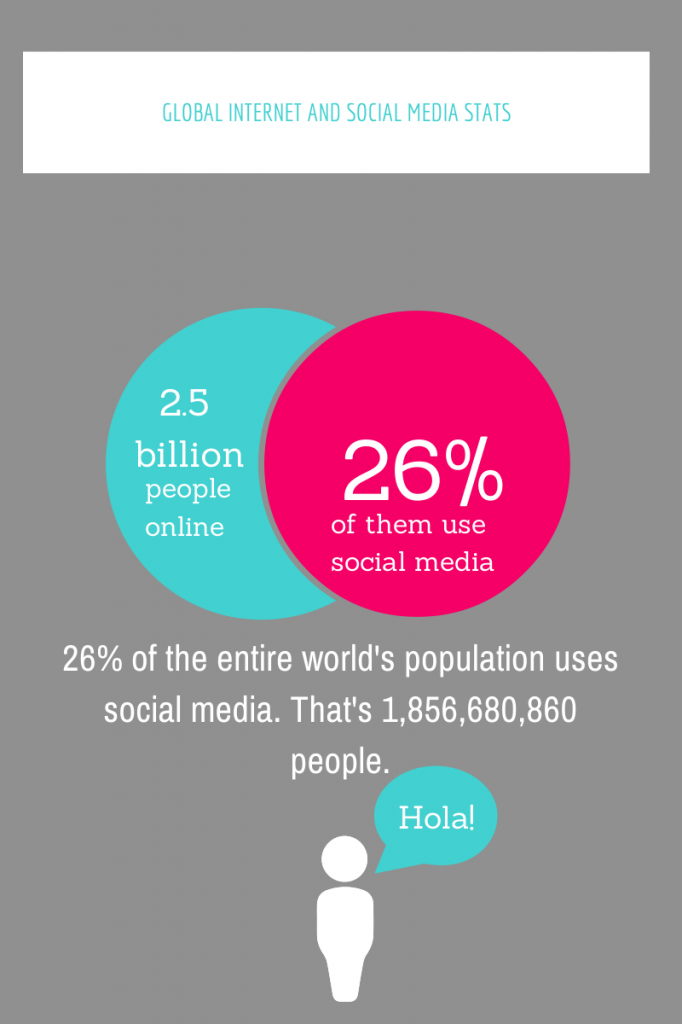Posted On:
Global online and social media stats at a glance
As web designers and online marketers, we can easily get swept away into thinking that social media is everywhere and that everyone is doing it. If they’re not, they should be. It’s surprising to us, therefore, to sometimes hear comments about how “useless” Twitter is or how people “waste time” on Facebook. We’re busy thinking about engagement, conversations, thought leadership, marketing and SEO – those don’t sound like useless things or a waste of time. In fact, social media enables businesses to conduct market research, gather leads and raise their brand profile at a fraction of the cost of traditional methods. Not everyone should categorically jump into social media for business. There are certain industries and professions which require a high level of confidentiality and discretion, and unless you can be open and transparent, social media is a tough place to be. However, even those businesses need to understand how social media impacts their business (people will still be online talking about you, or the type of product or service you provide) and what effect their decision not to be on social media might have on their business. One of the key factors in developing and implementing a successful social media strategy for business is internal cohesion about the aims, policies and practice. Every person in your organisation has to understand what your company is trying to do on social media and it can sometimes be difficult if social media is something delegated to an office junior and the senior management has no involvement in strategy or direction. This data might help convince senior executives that the trend in increasing social media use is following the trend of internet penetration very closely, and that it’s clear the growth will continue. This means being on social media is no longer optional for many businesses. Customer expectations have changed.  According to We Are Social, 35% of the world’s population of 7,095,476,818 people are online. Out of those, 52% of people live in urban areas and 48% in rural areas. 26% of the entire world’s population uses social media. That’s 1,856,680,860 people. By the time this blog post goes live, it will have gone up. Many of the global internet use figures come from mobile-only users. It is clear that in countries where internet penetration is lower, mobile-only use represents a larger proportion of the total figure. If you are interested in developing a persuasive case to adopt a more robust mobile-targeted or social media online marketing strategy for your business and need to persuade your senior managers into action, the SlideShare presentation by We Are Social will help you make your case. Mobile represents a large proportion of the growth of digital – and anyone who has analysed their website statistics will notice that the browser landscape and device breakdown really reflects this. According to Facebook, 50% of its users access it via a mobile device daily. Mobile penetration in Western Europe is 129% which means many people own multiple mobile devices. This is the largest area of interest for online marketers – and making your online content optimised for mobile is now a must. If you need help with online marketing, give us a call today on 01252 413757. We design brilliant websites for all types of clients (and are the Surrey County Council’s preferred digital partner). We also help with branding, logo design and copywriting. We are based in the Georgian market town of Farnham, Surrey and we love to help businesses succeed.
According to We Are Social, 35% of the world’s population of 7,095,476,818 people are online. Out of those, 52% of people live in urban areas and 48% in rural areas. 26% of the entire world’s population uses social media. That’s 1,856,680,860 people. By the time this blog post goes live, it will have gone up. Many of the global internet use figures come from mobile-only users. It is clear that in countries where internet penetration is lower, mobile-only use represents a larger proportion of the total figure. If you are interested in developing a persuasive case to adopt a more robust mobile-targeted or social media online marketing strategy for your business and need to persuade your senior managers into action, the SlideShare presentation by We Are Social will help you make your case. Mobile represents a large proportion of the growth of digital – and anyone who has analysed their website statistics will notice that the browser landscape and device breakdown really reflects this. According to Facebook, 50% of its users access it via a mobile device daily. Mobile penetration in Western Europe is 129% which means many people own multiple mobile devices. This is the largest area of interest for online marketers – and making your online content optimised for mobile is now a must. If you need help with online marketing, give us a call today on 01252 413757. We design brilliant websites for all types of clients (and are the Surrey County Council’s preferred digital partner). We also help with branding, logo design and copywriting. We are based in the Georgian market town of Farnham, Surrey and we love to help businesses succeed.